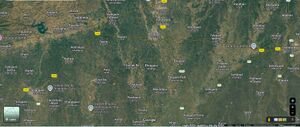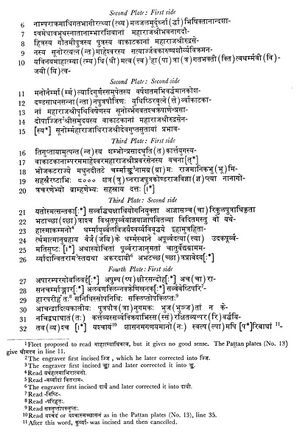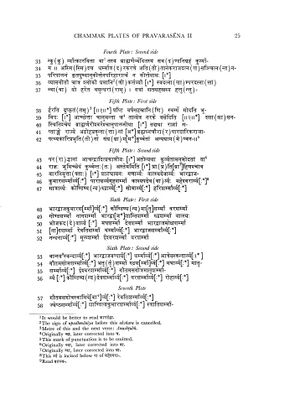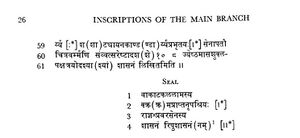Chamak
| Author:Laxman Burdak, IFS (R) |


Chamak (चमक) is village in Achalpur tahsil of Amravati district in Maharashtra. Chamak currently consists of a cluster of three villages on the banks of the Chandrabhaga River with those on the eastern bank known as Chamak Khurd and Chamak Buzurg. It is mentioned as Charmanka (चर्मांक) in Chammak Plates of 18th year of Pravarasena II.[1]
Variants
- Chammak
- Chamak Khurd/ Chamak Kh
- Chamak Buzurg / Chamak Bk
- Charmanka (चर्मांक) mentioned in Chammak Plates of 18th year of Pravarasena II
Location
Chamak Bk is a Village in Achalpur Taluka in Amravati District of Maharashtra State, India. It is situated 10km away from sub-district headquarter Achalpur and 50 km towards North from District head quarters Amravati. It belongs to Vidarbha region . It belongs to Amravati Division . Chamak Bk. Pin code is 444806 and postal head office is Achalpur City. Bhilona ( 3 KM ) , Bopapur ( 4 KM ) , Chausala ( 4 KM ) , Balegaon ( 4 KM ) , Bordi ( 4 KM ) are the nearby Villages to Chamak Bk.. Chamak Bk. is surrounded by Anjangaon S Taluka towards west , Chandur Bz Taluka towards East , Chikhaldara Taluka towards North , Bhatkuli Taluka towards South.[2]
Chamak or Chammak is located 6.0 miles SW of Achalpur according to Amravati district Gazetteer published by the Government of Maharashtra.[3]
According to J. F. Fleet the village is four miles s. w. of Ilichpur (Ellichpur). This is the old name for Achalpur.[4]
Chammak Plates of 18th year of Pravarasena II
[p.22]: These plates were found in about 1868 while ploughing a field at Chammak (ancient Charmanka (चर्मांक), a village about four miles south-west of Achalpur in the Amaravati District of Vidarbha. They were first brought to notice in 1879 by Pandit Bhagvanlal Indraji, who published his reading of the text in Pamphlet No. 9 of the Archaeological Survey of Western India, pp. 54 f. They were next edited, with a translation, by Dr. Buhler, first in the Archaeological Survey of Western India, Vol. IV, pp. 116 f, and again, with facsimiles of the plates, but not of the seal, in the Indian Antiquary, Vol. XII, pp. 239. Finally, they were published, with facsimiles and a translation, by Dr. Fleet in the Corpus Inscriptionum Indicarum, Vol. III, pp. 235 f. The original plates, which were obtained by Major H. Szczepanski, are not forthcoming now. The record is, therefore, edited here from Dr. Fleet’s lithographs.
‘The plates, of which the first and last are inscribed on one side only, are seven in number,....The characters are of the box-headed variety of the southern alphabets, but except in lines 58 and 59, the boxes at the top of the letters are scooped out hollow. They include the numerical symbols for 8 and 10 in line 60, and for 8000 in line 19. The sign of the upadhmānīya occurs in lines 13, 16 and 32. ....The language is Sanskrit, and except for the legend on the seal and two benedictive and imprecatory verses in lines 36-39, the whole record is in verse. As regards orthography, we may note the reduplication of a consonant before and after r as in kkrama in line 2 on the seal and saty-ārjjava- in line 9, that of the consonant preceding y is Bhāgiratthy-, line 6 and of v after an anusvāra in samvvatsare, line 60.
Like other complete grants of the Vakatakas, the present record opens with the word drishtam ‘seen ’. The plates were issued by Maharaja Pravarasena II of the Vakataka dynasty from Pravarapura. His genealogy is given here exactly as in the preceding two grants, his maternal grandfather being called Devagupta. The object of the inscription is to record the
[p.23]: grant, by Pravarasena II, of the village Charmanka situated on the bank of the Madhunadi in the rājya (division) of Bhojakata which consisted of 8000 nivartanas by the royal measure. The donees were a thousand Brahmanas1. The grant was made at the request of Kondaraja (कोण्डराज), the son of Shatrughnaraja (शत्रुघ्नराज). This Kondaraja is also mentioned in line 45 of the Pattan plates. The grant is dated on the thirteenth tithi of the bright fortnight of Jyestha in the 18th regnal year. The Senapati was Chitravarman. From the Belora plates, Set B, we know that Chitravarman was holding the same post seven years earlier in the 11th regnal year of Pravarasena II.
As for the localities mentioned in the present grant,
Pravarapura, which finds a mention here for the first time, was evidently the later capital of Pravarasena II. His earlier capital was Nandivardhana from which his two earlier grants were issued. Pravarapura was evidently founded by Pravarasena II and named after himself. He appears to have shifted his seat of government there some time after his eleventh regnal year. The exact location of Pravarapura was long uncertain; but the recent discovery of several sculptures of the Gupta-Vakataka period at Pavnar, 6 miles from Wardha, has rendered it probable that the village marks the site of ancient Pravarapura.
Charmanka is, of course, Chammak where the plates were discovered.
The Madhunadi on the bank of which it was situated is now called Chandrabhaga.
Bhojakata, the headquarters of the division (rajya) in which Charmanka was included, is an ancient city. It was founded by Rukmin, the brother-in-law of Krishna. When the latter abducted his sister Rukmini, he vowed that he would not return to Kundinapura, the capital of Vidarbha, unless he killed Krishna and rescued his sister. As he did not succeed in this, he refused to return to Kundinapura, but founded a new city named Bhojakata where he fixed his residence2. Bhojakata is usually identified with Bhatkuli (भाटकुली), a village about 8 miles from Amaravati where there is still a temple of Rukmin. Some images of Jain Tirthankaras were also discovered there several years ago.
1 Though the Brahmana donees are said to have numbered a thousand, only 49 are actually mentioned at the end of the record. Perhaps they represented others or were the heads of the families. It is also not unlikely that the word sahasra is used indefinitely in the sense of a large number. Cf. varsha-sahasra-go- brahmana . ... in line 15 of the Junagadh rock inscription of Rudradaman, Ep. Ind., Vol. VIII, p. 44, and vasa-sata-sahasāya in the Prakrit grant of Sivaskandavarman, ibid., Vol. I, p. 7.
2Cf. अनानीय स्वसारं तु रूक्मी मानमदान्वित:। हीनप्रतिज्ञो नैच्छ्त्स प्रवेष्टुं कुण्डिनं पुरम् ॥ विदर्भेषु निवासार्थ निर्ममेSन्यत्पुरं महत् । तद्भोजकटमित्येव बभूव भुवि विश्रुतम् ॥ Harivansha, II, 60, 31-32




[p.26]: Seen. Hail! From Pravarapura —
By the order of the illustrious Pravarasena (II), the Maharaja of the Vakatakas, who is a fervent devotee of Mahesvara, who, by the grace of Shambhu, has established the Krita-yuga (Golden Age) (on the earth), who was born of Prabhavatigupta the daughter of the Maharajaradhiraja, the illustrious Devagupta, and who is the son of the Maharaja , the illustrious Rudrasena (II) —
(Line 18). The village named Charmanka (consisting of) eight thousand — 8000-(nivartanas) of land, according to the royal measure, (situated) on the bank of the (river) Madhunadi in the rajya of Bhojakata, has, at the request of Kondaraja, the son of Satrughnaraja, been given to a thousand Brahmanas of various gotras and charanas.
(Line 36). The (following) two verses sung by Vyasa should be regarded as an authority on this point; —
(Here occur two benedictive and imprecatory verses.)
(Line 39). And this condition of the charter should be maintained by the Brahmanas and (future) kings : — (This grant shall be enjoyed by the Brahmarias) as long as the sun and the moon will endure, provided that they commit no treason against the kingdom consisting of seven constituents2 of the (future) kings ; that they are not found guilty of the murder of a Brahmana, theft, adultery and high treason, etc.; that they do not wage war; (and) that they do no harm to other villages. But if they act otherwise or assent to such acts, the king will commit no theft if he takes the land away (from them).
(Line 44). And the recipients (of the grant) appointed for the occasion in this respect are (as follows) : —
Ganârya of the Shâtyâyana (gôtra). Dêvârya of the Vâtsya (gôtra); Kumârasharmârya of the Bhâradvâja (gôtra); Guhasharman of the Pârâsharya (gôtra); Dêvârya of the Kashyapa (gôtra); Mahêshvarârya (and) Mâtrârya3; Rudrârya of the Kaundinya (gôtra); (and) Sômârya (and) Harisharmârya; Kumârasharmârya of the Bharadvaja (gôtra); Mâtrisharman of the Kaundinya (gôtra); (and) Varasharman , Gôndasharman (and) Nâgasharman; Shântisharman of the Bharadvâja (gôtra); (and) Rudrasharman, Bhôjakadêvârya of the Vatsya (gôtra); (and) Maghasharman (and) Dêvasharman; Môkshasharman of the Bhâradvaja (gôtra); (and) Nâgasharman, Rêvatisharman,
2 These are the king, his ministers, ally, territory, treasure, fortress and army.
3 These two also probably belonged to the same gotra Kashyapa. So also in the following, where no gotra is mentioned, that named before is to be understood.
[p.27]: (and) Dharmârya, Sharmârya, of the Bharadvaja (gôtra); (and) Nandanârya, Mûlasharman, Îshvarasharman, (and) Varasharman; Skandârya of the Vatsya (gôtra); Bappârya of the Bharadvaja (gôtra); (and) Dharmârya; Skandârya of the Âtrêya (gôtra); Sômasharmârya of the Gautama (gôtra); (and) Bhartrisharman; Rudrasharmârya, Maghârya, Mâtrisharmârya, (and) Îshvarasharmârya; Mâtrisharmârya of the Gautama (gôtra); Dêvasharmârya of the Kaundinya (gôtra); (and) Varasharmârya (and) Rôhârya; Svâmidêvârya of the Gautama (gôtra); (and) Rêvatisharmârya (and) Jyêshthasharmârya; Kumârasharmârya of the Shandilya (gôtra); (and) Svâtisharmârya; (And) Kândârya of the Shâtyâyana (gôtra) and others.
(Line 59). (This) charter has been written, Chitravarman being the Senapati, on the thirteenth (lunar day) of the bright fortnight of the month Jyeshtha in the eighteenth 10 (and) 8 — (regnal) year.
(This is) the enemy-chastising command of the king Pravarasena (II), the ornament of the Vakatakas, who has attained royal fortune by inheritance.
Wiki Editor Notes:
- Bhat (भट) (Jat clan) → Bhatkuli (भाटकुली) = Bhojakata (भोजकट). Bhojakata (भोजकट) mentioned in Chammak Plates of 18th year of Pravarasena II, the ancient town founded by 'Rukmi, the brother-in-law of Krishna, is usually identified with Bhatkuli (भाटकुली), a village about 8 miles from Amaravati where there is still a temple of Rukmi. (p.23)[5]
- Bhoj (भोज)/ Bhojak (भोजक) (Jat clan) → Bhojakata (भोजकट) mentioned in Chammak Plates of 18th year of Pravarasena II, the ancient town founded by 'Rukmi, the brother-in-law of Krishna, is usually identified with Bhatkuli, a village about 8 miles from Amaravati where there is still a temple of Rukmi. (p.23)[6]
- Chamkane (चमकाने) (Jat clan) → Chamak (चमक) is village in Achalpur tahsil of Amravati district in Maharashtra. It is mentioned as Charmanka (चर्मांक) in Chammak Plates of 18th year of Pravarasena II.[7]
- Madhu (मधु) (Jat clan) → Madhunadi (मधुनदी) mentioned in Chammak Plates of 18th year of Pravarasena II, on the bank of which it was situated is now called Chandrabhaga.[8]
Comments on Chamak copper plates
The Chamak copper plates are an epigraphic record of the Vākāṭaka dynasty, documenting a land donation to brāhmaṇas in the reign king Pravarasena II in the fifth century CE. They were found at Chamak, in District Amravati, Maharashtra, India.
The plates were found in a field near the village in the 19th century and were acquired by Major H. Szczepanski. They are now in the collection of the British Library registered under the number Ind. Ch. no. 16.[9]
The Chamak copper-plate charter was read and published by John Faithfull Fleet in 1888.[10]
The record was subsequently published by V. V. Mirashi in 1963.[11]
Description and Contents
The Chamak charter consists of a series of copper plates linked together with a ring held with a seal. The text of the inscription is Sanskrit throughout. The object of the inscription is to record the grant, by Pravarasena II, of the village Charmāka situated on the bank of the Madhunadī in the rājya of Bhojakaṭa. The grant consisted of 8000 bhūmi-s by the royal measure. The donees were a "thousand Brāhmaṇas", although only 49 are actually named. The grant was made at the request of Koṇḍarāja, the son of Śatrughnarāja. This Koṇḍarāja is also mentioned in line 45 of the Pattan copper plates. The grant is dated on the thirteenth tithi of the bright fortnight of Jyeṣṭha in the 18th regnal year. The senāpati was Chitravarman. From the Belorā copper plates, Set B, we know that Chitravarman was holding the same post seven years earlier in the 11th regnal year of Pravarasena II.
Chammak Plates of the Maharaja Pravarasena II
|
| Chammak Plates of the Maharaja Pravarasena II[12] |
Commentaries and variants.
- L.1 Read ṣoḍaśy-atirātra-. (Mi.)
- L.3 Read Viṣṇuvṛddha; Mi. read samrājo.
- L.10 Fleet proposed to read māhātmyādhikatva, but it gives no good sense. The Paṭṭan plates(No. 13) give dhīmattva in line 11.
- L.14 Engraver at first write jji, then correct to rjji. (Mi.)
- L.18 Engraver at first write ṅkā, then correct to ṅka. (Mi.)
- L.23 Read yath-eh-āsmābhir-ātmano. (Mi.)
- L.26 Read -maryyādāṃ vitarāma-; Engraver at first wrote dāyai, then correct to dāyī. (Mi.)
- L.28 Read viṣṭi-. (Mi.)
- L.29 Read parihṛtaḥ; sakлptopakлiptaḥ. (Mi.)
- L.32 Read yaścedaṃ or yaścāsmacchāsanaṃ as in No.13. l.35; after [pa*]ribādhāṃ - kuryyā engraved, then cancelled. (Mi.) L.33 Read kārayedvā. (Mi.)
- L.36 The sign of upadhmānīya after pramāni(ṇī) is cancelled. (Mi.)
- L.39 Originally ccha, later corrected into ca. (Mi.)
- L.42 To ṣvana-|| - this punktuation mark must be omitted. (Mi.)
- L.43 Originally vvā, later corrected into vā. (Mi.)
- L.44 To prā(pra)ti[grā]hiṇaś- : originally gvā, later corrected into grā. (Mi.)
- L.46 To Maheśvarāryya[ḥ*]: this -ryya incised below rā of maheśvarā. (Mi.)
- L.53 To Vānsya-: read vātsya. (Mi.)
English Translation
- A charter of king Pravarasêna, the ornament of the Vâkâtakas, who has attained royal dignity by, inheritance, (is) a charter for (the observance of even his) enemies!
- Sight has been attained! Hail! From the town of Pravarapura;
- (Line 17.)-At the command of the most devout worshipper of (the god) Maheshvara, the Mahârâja of the Vâkâtakas, the illustrious Pravarasêna (II.), who was begotten on Prabhavatigupta, the daughter of the Mahârâjadhirâja, the glorious Dêvagupta; who, through possessing the favour of (the god) Shambhu, is (as virtuous as) one belonging to the Krita age;-
- (Line 13.) -(And) who is the son of the Mahârâja of the Vâkâtakas, the illustrious Rudrasêna (II.), who acquired an abundance of good fortune through the favour of the divine (god) Chakrapâni;
- (L. 9.)-Who was the son of the Mahârâja of the Vâkâtakas, the illustrious Prithivishena, who was an excessively devout worshipper of (the god) Mahêshvara; who was endowed with an excess of truthfulness, straightforwardness, tenderness, heroism, prowess, political wisdom, modesty, and high-mindedness, and with devotion to worthy people and guests, and with the condition of being victorious through religion, and with purity of mind, and with other meritorious qualities; who belonged to an uninterrupted succession of sons and sons' sons, whose treasure and means of government had been accumulating for a hundred years; who behaved like Yudhishthira;-
- (L. 4.)-Who was the son of the Mahârâja of the Vâkâtakas, the illustrious Rudrasêna (I.), who was an excessively devout devotee of (the god) Svâmi-Mahâbhairava; who was the daughter's son of the illustrious Bhavanaga, the Mahârâja of the Bhârashivas, whose royal line owed its origin to the great satisfaction of (the god) Shiva, (caused) by (their) carrying a linga of Shiva placed as a load upon (their) shoulders, (and) who were besprinkled on the forehead with the pure water of (the river) Bhâgirathî that had been obtained by (their) valour, (and) who performed ablutions after the celebration of ten ashvamêdha-sacrifices;-who was the son of Gautamiputra;-
- (L. 1.)-(And) who was the son of the son of the Mahârâja of the sovereign Vâkâtakas, the illustrious Pravarasêna (I.), who celebrated the agnishtôma, aptôryâma, ukthya, shôdashin, âtirâtra, vâjapêya, brihaspatisava, and sâdyaskra sacrifices and four ashvamêdha-sacrifices, (and) was of the Vishnuvriddha gôtra;-
- (L. 18.)-The village named Charmânika, on the bank of the river Madhunadi, in the Bhôjakata kingdom, (measured) by eight thousand bhûmis, (or in figures) 8000, according to the royal measure, is, at the request of Kondarâja the son of Satrughnarâja, given to one thousand Brâhmans of various gôtras and charanas.
- (L. 21.)-Wherefore Our obedient and high-born officers, employed in the office of general superintendents, (and Our) regular soldiers and umbrella-bearers, should be (thus) directed with a command preceded by (the words) ‘O illustrious one’:- Be it known to you, that, in order to increase Our religion and life and strength and victory and dominion, (and) for the sake of (Our) welfare in this world and in the next, (and generally) for Our benefit, this (village) is granted, in (Our) victorious office of justice, as a grant not previously made, with libations of water.
- (L. 25.)- "Now We grant the fixed usage, such as befits this (village), (and) such as has been approved of by former kings, of a village which belongs to a community of Chaturvêdins; namely, it is not to pay taxes; it is not to be entered by the regular troops or by the umbrella-bearers; it does not carry with it (the right to) cows and bulls in succession of production, or to the abundance of flowers and milk, or to the pasturage, hides, and charcoal, or to the mines for the purchase of salt in a moist state; it is entirely free from (all obligation of) forced labour; it carries with it the hidden treasures and deposits, and the klripta and upaklripta; it is (to be enjoyed) for the same time with the moon and the sun; (and) it is to follow (the succession of) sons and sons' sons. No hindrance should be caused by any one to those who enjoy it. It should be protected and increased by all (possible) means. And whosoever, disregarding this charter, shall give, or cause to be given, even slight vexation, We will inflict on him punishment, together with a fine, when he is denounced by the Brâhmans."
- (L. 34.)-And in this document, which has at least (the merit of) religion,-in order to avoid boasting of (other) meritorious actions performed (by Us),--We do not recite (Our) care and protection of grants made by various kings who are dead and gone.
- (L. 36.)-And two verses, sung by Vyâsa, are to be cited as an authority on this point: -Whosoever confiscates land that has been given, whether by himself, or by another, he incurs the guilt of the slayer of a hundred thousand cows! The giver of land enjoys happiness in heaven for sixty thousand years; (but) the confiscator (of a grant), and he who assents (to an act of confiscation), shall dwell for the same number of years in hell!
- (L. 39.)-And this condition of the charter should be maintained by the Brâhmans and by (future) lords; namely (the enjoyment of this grant is to belong to the Brâhmans) for the same time with the moon and the sun, provided that they commit no treason against the kingdom, consisting of seven constituent parts, of (successive) kings; that they are not slayers of Brâhmans, and are not thieves, adulterers, poisoners of kings, &c.; that they do not wage war; (and) that they do no wrong to other villages. But, if they act otherwise, or assent (to such acts), the king will commit no theft in taking the land away.
- (L. 44.)-And the recipients, appointed for the occasion in this matter, (are):
- Ganârya, of the Shâtyâyana (gôtra).
- Dêvârya, of the Vâtsya (gôtra).
- Kumârasharmârya, of the Bhâradvâja (gôtra). :Guhasharman, of the Pârâsharya (gôtra).
- Dêvârya, of the Kashyapa (gôtra);
- Mahêshvarârya, (and) Mâtrârya. Rudrârya, of the Kaundinya (gôtra); (and)
- Sômârya, (and) Harisharmârya. Kumârasharmârya, of the Bharadvaja (gôtra).
- Mâtrisharman, of the Kaundinya (gôtra); (and) :Varasharman, Gôndasharman, (and) Nâgasharman. :Shântisharman, of the Bharadvâja (gôtra); (and) :Rudrasharman, Bhôjakadêvârya, of the Vatsya (gôtra); (and) :Maghasharman, (and) Dêvasharman.
- Môkshasharman, of the Bhâradvaja (gôtra); (and)
- Nâgasharman, Rêvatisharman,
(and) Dharmârya, Sharmârya, of the Bharadvaja (gôtra); (and)
- Nandanârya, Mûlasharman, Îshvarasharman, (and) Varasharman.
- Skandârya, of the Vatsya (gôtra).
- Bappârya, of the Bharadvaja (gôtra); (and) Dharmârya.
- Skandârya, of the Âtrêya (gôtra),
- Sômasharmârya, of the Gautama (gôtra); (and)
- Bhartrisharman, Rudrasharmârya, Maghârya, Mâtrisharmârya, (and) Îshvarasharmârya.
- Mâtrisharmârya, of the Gautama (gôtra).
- Dêvasharmârya, of the Kaundinya (gôtra); (and)
- Varasharmârya, (and) Rôhârya.
- Svâmidêvârya, of the Gautama (gôtra); (and)
- Rêvatisharmârya, (and) Jyêshthasharmârya.
- Kumârasharmârya, of the Shandilya (gôtra); (and) :Svâtisharmârya. (And) Kândârya, of the Shâtyâyana (gôtra); and so forth.
- (L. 59.)-(This) charter has been written, while Chitravarman is the Sênâpati, in the eighteenth year, (or in figures) 10 (and) 8, on the thirteenth lunar day of the bright fortnight of the month Jyêshtha.
- From: Fleet, John F. Corpus Inscriptionum Indicarum: Inscriptions of the Early Guptas. Vol. III. Calcutta: Government of India, Central Publications Branch, 1888, 240-243.
References
- ↑ Corpus Inscriptionum Indicarum Vol.5 (inscriptions Of The Vakatakas), Edited by Vasudev Vishnu Mirashi, 1963, Archaeological Survey of India, p.22-27
- ↑ https://www.onefivenine.com/india/villages/Amravati/Achalpur/Chamak-Bk.
- ↑ Amravati district Gazetteer
- ↑ J. F. Fleet, Inscriptions of the Gupta Kings and their Successors, CII, vol. 8, Calcutta, 1888.
- ↑ Corpus Inscriptionum Indicarum Vol.5 (inscriptions Of The Vakatakas), Edited by Vasudev Vishnu Mirashi, 1963, Archaeological Survey of India, p.22-27
- ↑ Corpus Inscriptionum Indicarum Vol.5 (inscriptions Of The Vakatakas), Edited by Vasudev Vishnu Mirashi, 1963, Archaeological Survey of India, p.22-27
- ↑ Corpus Inscriptionum Indicarum Vol.5 (inscriptions Of The Vakatakas), Edited by Vasudev Vishnu Mirashi, 1963, Archaeological Survey of India, p.22-27
- ↑ Corpus Inscriptionum Indicarum Vol.5 (inscriptions Of The Vakatakas), Edited by Vasudev Vishnu Mirashi, 1963, Archaeological Survey of India, p.22-27
- ↑ A. Gaur, Indian charters on copper plates in the Department of Oriental Manuscripts and Printed Books (London, 1975).
- ↑ J. F. Fleet, Inscriptions of the Gupta Kings and their Successors, p. 236.
- ↑ V. V. Mirashi, Inscriptions of the Vākāṭakas, CII 5 (Ootacamund, 1963), available online
- ↑ Fleet, John F. Corpus Inscriptionum Indicarum: Inscriptions of the Early Guptas. Vol. III. Calcutta: Government of India, Central Publications Branch, 1888, 240-243.
Back to Inscriptions

